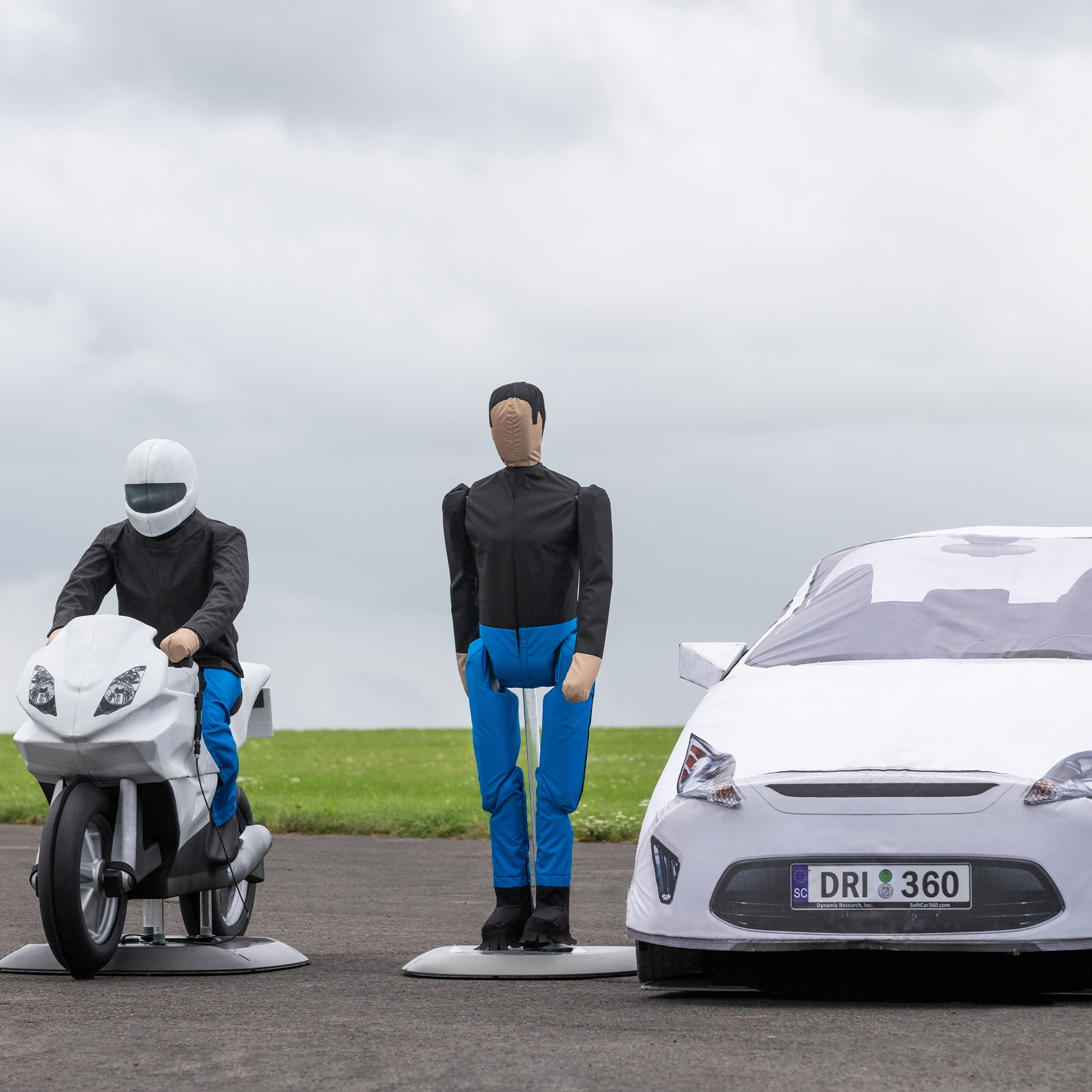What does FMVSS 127 mean for automotive testing?

Earlier this year, NHTSA's FMVSS 127 rule mandated that all cars and light trucks sold in the US must be fitted with AEB (Automated Emergency Braking) from 2029. In this roundtable discussion with AB Dynamics’ Director of Track Testing, Dr. Andrew Pick (AP), and DRI’s Director of Track Testing, Nadine Wong (NW), we take an in-depth look into how OEMs and test houses can get ahead of FMVSS 127.
AEB is a recognized and established technology, what does the current landscape look like in the US?
NW: Exactly, there is nothing new about AEB. In fact, around 90% of new passenger vehicles in the US are offered with the technology. FMVSS 127 is aiming to not only increase this to 100%, by making it mandatory, but it is also requiring that the performance and capability of these systems be improved, which is reflected in the testing requirements.
ABD: So what exactly is FMVSS 127 and what capabilities is it aiming to improve?
AP: FMVSS 127 (Federal Motor Vehicle Safety Standard) is a regulation mandating that passenger vehicles and trucks in the US must be fitted with AEB as standard by 2029. Specifically, it states that vehicles have an AEB system and FCW (Forward Collision Warning) that operate at any forward speed greater than 10 km/h (6 mph) and less than 145 km/h (90 mph). The AEB system should be capable of preventing collisions with stationary objects at speeds up to 100 km/h (62 mph) and detecting pedestrians in both daylight and darkness. In addition, the standard requires that the FCW system provides an auditory and visual warning to the driver to apply the brakes up to 145 km/h (90 mph) when a collision with a lead vehicle is imminent, while automatic braking is required up to 73 km/h (45 mph) when a pedestrian is detected.
That sounds like a demanding set of requirements for manufacturers to meet, is FMVSS 127 achievable?
NW: We have already conducted extensive FMVSS 127 testing for clients and regularly work directly with NHTSA to test and develop new protocols, so DRI has a lot of experience in this area. We know that there are vehicles currently available that already come close to achieving the standard. In our experience, the more challenging area is the nighttime PAEB (Pedestrian Automatic Emergency Braking) tests, which will likely require further advancements and developments in sensor technologies.
AP: Luckily, OEMs currently have five years to achieve these required advancements. The combination of high-speed tests as well as detecting pedestrians at nighttime may require more sophisticated sensor systems than are commonly used today, such as long-range radar and LiDAR.
What specifically is driving the need for more advanced sensors, why is it more challenging?
NW: The high-speed nature of these tests is certainly one of the key challenges. The 90 mph (145 km/h) test dictated by FMVSS 127 is one of the highest mandated test speeds globally for active safety systems. It significantly increases the required field of view of sensors, as well as the braking distances involved. This also has implications for the practicalities of testing; necessitating more room to get the vehicle up to speed and the increased potential for damage caused to the vehicle under test and other test equipment.
AP: As Nadine previously mentioned, perhaps the main challenge is the PAEB tests at nighttime. While some Euro NCAP night tests allow for street lighting, FMVSS 127 mandates testing in complete darkness and in the most challenging cases low beam lighting only to illuminate the scene ahead. This makes detecting the pedestrian more difficult for sensor systems.
NW: And to top it off, FMVSS 127 requires a 100% pass rate, leaving no room for error, unlike other international AEB standards that allow for a margin of acceptable failure.
How does the regulation compare with its European counterparts?
AP: You can make the argument that FMVSS 127 is one of the most challenging active safety regulations to achieve. The equivalent standard in Europe is the UNECE R152 regulation, which is a mandatory requirement that came into force in 2020. FMVSS 127 has requirements up to 145 km/h (90 mph), while UNECE R152 is limited to just 60km/h (37mph). FMVSS 127 mandates a non-contact result, or complete collision avoidance, while in comparison UNECE allows for collision mitigation as well as avoidance. Also applicable in the region, although not mandatory, is Euro NCAP’s set of AEB protocols.
What’s more challenging; NHTSA’s FMVSS 127 or Euro NCAP’s AEB protocol?
NW: NHTSA is certainly raising the bar with FMVSS 127. On the face of it FMVSS 127 is more challenging. Euro NCAP test speeds are limited to just 80 km/h (50 mph) and, similar to R152, collision mitigation is acceptable, and a 100% pass rate is not required. However, where Euro NCAP’s AEB protocols are more challenging to meet is they cover a much broader range of speeds and scenarios. For example, the inclusion of cyclists, motorcyclists, turning at intersections, curved roads and lane changes. This necessitates sideways-looking sensors and a more discerning AEB system.
So that’s why achieving the protocol is challenging but how about conducting the testing itself, will FMVSS 127 require a new approach on the test track?
NW: At DRI, we have developed a very flexible test methodology that enables us to accommodate a broad range of tests. We have adapted our approach to accommodate FMVSS 127 and we have experience conducting tests for customers.
However, the high-speed nature does necessitate additional track. Getting an average family car from 80-140km/h (50-87mph) can add 200-300m to the required space. The speed also makes the use of an automated abort procedure preferable during repeated testing to avoid having to constantly reassemble impacted ADAS targets.
How does the abort procedure work?
AP: We have developed an automated abort maneuver procedure, which can be programmed into our software. We can do this because our system closely controls and coordinates both the vehicle under test through our driving robots and the test objects via our LaunchPad and GST test platforms. When the AEB system doesn’t intervene before a collision is imminent our software can automatically take action to either brake or steer to avoid or mitigate a collision. When vehicle speeds are in excess of 145 km/h (90 mph) this abort maneuver could be critical in keeping a test programme on schedule.
NW: We use this system at our proving ground in California to reduce downtime and maximize test efficiency, which is crucial to a successful test programme. To further increase efficiency, we are also working with AB Dynamics to create, test and validate the FMVSS 127 ‘Special Group’ to automate more of the test programme.
How do the ‘Special Groups’ help with testing?
AP: Our Special Groups are a library of pre-defined test scenarios. Combined with our driving robots, ADAS targets and other track test equipment, it enables test engineers to automate the creation, set-up, variation, execution and verification of industry-standard active safety protocols. The FMVSS 127 Special Group is currently being trialed with DRI and will be available to customers soon.
NW: It saves us a lot of time at the track and provides a real-time pass or fail, which is incredibly useful in planning what scenario to conduct next.
Finally, what should OEMs be doing to get ahead of FMVSS 127?
AP: Start testing sooner rather than later! OEMs need to understand where they fall short on the regulation and why, and the best way to do that is to test with current vehicle models to see how they stack up. This will help them to focus development to ensure they are ready for 2029.
NW: I agree with Andrew, and we are already experiencing an increase in enquiries from OEMs looking to do just that.
Key Takeaways
- High-speed collision avoidance: FMVSS 127 mandates that AEB systems must prevent collisions with stationary objects at speeds up to 100 km/h (62 mph) and apply the brakes automatically up to 145 km/h (90 mph), significantly increasing the operating domain for AEB.
- Nighttime testing challenges: Unlike Euro NCAP, FMVSS 127 includes testing in complete darkness with only vehicle lighting, significantly increasing the challenge of pedestrian detection.
- Stringent pass requirements: FMVSS 127 requires a 100% pass rate for a mandated test, leaving no room for error, in contrast to other standards that allow some failures.
- Technological advancements Needed: FMVSS 127 pushes the boundaries of what is possible from current AEB technologies. More sophisticated sensor systems, such as long-range radar and LiDAR, may be required by 2029.
- Get ahead of FMVSS 127: OEMs and suppliers need to start testing the requirement now to understand where their current technologies fall short and where to focus development.
For more information on how DRI can support your FMVSS 127 programme, contact us here.



